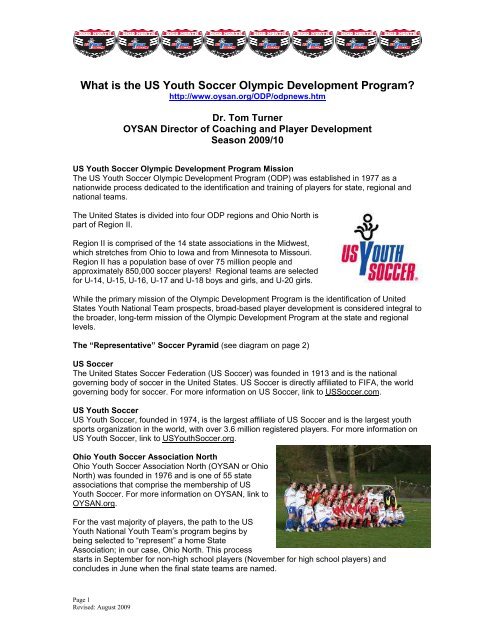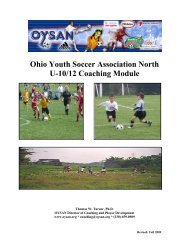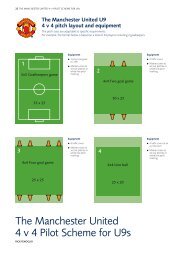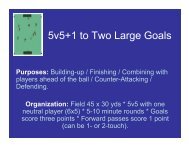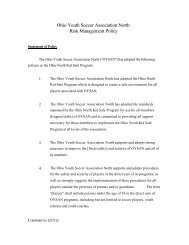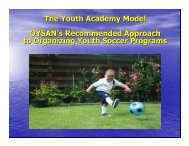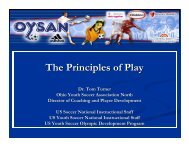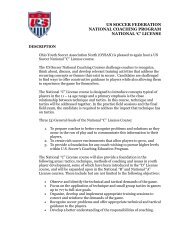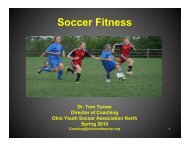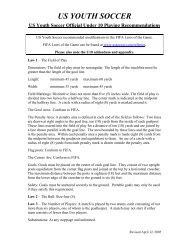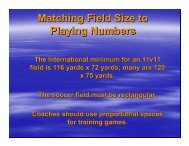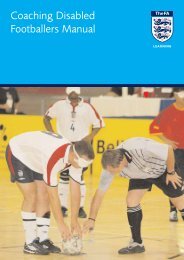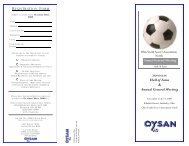What is the US Youth Soccer Olympic Development Program?
What is the US Youth Soccer Olympic Development Program?
What is the US Youth Soccer Olympic Development Program?
You also want an ePaper? Increase the reach of your titles
YUMPU automatically turns print PDFs into web optimized ePapers that Google loves.
<strong>What</strong> <strong>is</strong> <strong>the</strong> <strong>US</strong> <strong>Youth</strong> <strong>Soccer</strong> <strong>Olympic</strong> <strong>Development</strong> <strong>Program</strong><br />
http://www.oysan.org/ODP/odpnews.htm<br />
Dr. Tom Turner<br />
OYSAN Director of Coaching and Player <strong>Development</strong><br />
Season 2009/10<br />
<strong>US</strong> <strong>Youth</strong> <strong>Soccer</strong> <strong>Olympic</strong> <strong>Development</strong> <strong>Program</strong> M<strong>is</strong>sion<br />
The <strong>US</strong> <strong>Youth</strong> <strong>Soccer</strong> <strong>Olympic</strong> <strong>Development</strong> <strong>Program</strong> (ODP) was establ<strong>is</strong>hed in 1977 as a<br />
nationwide process dedicated to <strong>the</strong> identification and training of players for state, regional and<br />
national teams.<br />
The United States <strong>is</strong> divided into four ODP regions and Ohio North <strong>is</strong><br />
part of Region II.<br />
Region II <strong>is</strong> compr<strong>is</strong>ed of <strong>the</strong> 14 state associations in <strong>the</strong> Midwest,<br />
which stretches from Ohio to Iowa and from Minnesota to M<strong>is</strong>souri.<br />
Region II has a population base of over 75 million people and<br />
approximately 850,000 soccer players! Regional teams are selected<br />
for U-14, U-15, U-16, U-17 and U-18 boys and girls, and U-20 girls.<br />
While <strong>the</strong> primary m<strong>is</strong>sion of <strong>the</strong> <strong>Olympic</strong> <strong>Development</strong> <strong>Program</strong> <strong>is</strong> <strong>the</strong> identification of United<br />
States <strong>Youth</strong> National Team prospects, broad-based player development <strong>is</strong> considered integral to<br />
<strong>the</strong> broader, long-term m<strong>is</strong>sion of <strong>the</strong> <strong>Olympic</strong> <strong>Development</strong> <strong>Program</strong> at <strong>the</strong> state and regional<br />
levels.<br />
The “Representative” <strong>Soccer</strong> Pyramid (see diagram on page 2)<br />
<strong>US</strong> <strong>Soccer</strong><br />
The United States <strong>Soccer</strong> Federation (<strong>US</strong> <strong>Soccer</strong>) was founded in 1913 and <strong>is</strong> <strong>the</strong> national<br />
governing body of soccer in <strong>the</strong> United States. <strong>US</strong> <strong>Soccer</strong> <strong>is</strong> directly affiliated to FIFA, <strong>the</strong> world<br />
governing body for soccer. For more information on <strong>US</strong> <strong>Soccer</strong>, link to <strong>US</strong><strong>Soccer</strong>.com.<br />
<strong>US</strong> <strong>Youth</strong> <strong>Soccer</strong><br />
<strong>US</strong> <strong>Youth</strong> <strong>Soccer</strong>, founded in 1974, <strong>is</strong> <strong>the</strong> largest affiliate of <strong>US</strong> <strong>Soccer</strong> and <strong>is</strong> <strong>the</strong> largest youth<br />
sports organization in <strong>the</strong> world, with over 3.6 million reg<strong>is</strong>tered players. For more information on<br />
<strong>US</strong> <strong>Youth</strong> <strong>Soccer</strong>, link to <strong>US</strong><strong>Youth</strong><strong>Soccer</strong>.org.<br />
Ohio <strong>Youth</strong> <strong>Soccer</strong> Association North<br />
Ohio <strong>Youth</strong> <strong>Soccer</strong> Association North (OYSAN or Ohio<br />
North) was founded in 1976 and <strong>is</strong> one of 55 state<br />
associations that compr<strong>is</strong>e <strong>the</strong> membership of <strong>US</strong><br />
<strong>Youth</strong> <strong>Soccer</strong>. For more information on OYSAN, link to<br />
OYSAN.org.<br />
For <strong>the</strong> vast majority of players, <strong>the</strong> path to <strong>the</strong> <strong>US</strong><br />
<strong>Youth</strong> National <strong>Youth</strong> Team’s program begins by<br />
being selected to “represent” a home State<br />
Association; in our case, Ohio North. Th<strong>is</strong> process<br />
starts in September for non-high school players (November for high school players) and<br />
concludes in June when <strong>the</strong> final state teams are named.<br />
Page 1<br />
Rev<strong>is</strong>ed: August 2009
Once named to a state team, <strong>the</strong> selection process to represent Region II (North) takes place<br />
during <strong>the</strong> regional camps held each July in Illino<strong>is</strong> (Girls) and Kansas (Boys). Th<strong>is</strong> <strong>is</strong> <strong>the</strong> endpoint<br />
of <strong>the</strong> State Association ODP process.<br />
The primary identification opportunity for <strong>the</strong> <strong>US</strong> <strong>Soccer</strong> <strong>Youth</strong> National Teams (YNT) takes place<br />
each fall at <strong>the</strong> <strong>US</strong> <strong>Youth</strong> <strong>Soccer</strong> ODP inter-regional events.<br />
The goal of <strong>the</strong> YNT selection process <strong>is</strong> to monitor known talent and d<strong>is</strong>cover new players. The<br />
YNT selection process <strong>is</strong> <strong>the</strong>refore ongoing and players who are identified at any event in any<br />
location during <strong>the</strong> year can be steered towards a state or regional program or invited into a YNT<br />
training camp, as schedule and ability dictates.<br />
The Representative<br />
<strong>Soccer</strong> Pyramid:<br />
From OYSAN to <strong>the</strong> <strong>US</strong><br />
National <strong>Youth</strong> Teams<br />
<strong>Program</strong><br />
<strong>US</strong> <strong>Soccer</strong><br />
National <strong>Youth</strong><br />
Teams <strong>Program</strong><br />
( U-14, U-15, U-17, U-18, U-20)<br />
<strong>US</strong> <strong>Youth</strong> <strong>Soccer</strong><br />
<strong>Olympic</strong> <strong>Development</strong> <strong>Program</strong><br />
Four Regional <strong>Program</strong>s<br />
East: R-I (15 States) North: R-II (14 States)<br />
South: R-III (12 States) West: R-IV (14 States)<br />
<strong>US</strong> <strong>Youth</strong> <strong>Soccer</strong><br />
<strong>Olympic</strong> <strong>Development</strong> <strong>Program</strong><br />
55 State Association Teams<br />
(OYSAN)<br />
<strong>US</strong> <strong>Youth</strong> <strong>Soccer</strong><br />
Ohio <strong>Youth</strong> <strong>Soccer</strong> Association North<br />
Club and Community Teams<br />
Age Groups<br />
International competition, and <strong>the</strong>refore ODP selection, <strong>is</strong> based on a January 1 st to December<br />
31 st calendar year. The OYSAN state team selection process during season 2009/10 concludes<br />
in July 2010 with <strong>the</strong> regional pool selections for season 2010/11. The regional camp age groups<br />
l<strong>is</strong>ted below in paren<strong>the</strong>ses refer to <strong>the</strong> regional pools for seasonal year 2010/11.<br />
ODP birth years for 2009-10 are as follows:<br />
1998’s (Attend July 2010 Regional Camp in <strong>the</strong> U-13 <strong>Development</strong>al <strong>Program</strong>)<br />
1997’s (Attend July 2010 Regional Camp as U-14’s for season 2010/2011)<br />
1996’s (Attend July 2010 Regional Camp as U-15’s for season 2010/2011)<br />
1995’s (Attend July 2010 Regional Camp as U-16’s for season 2010/2011)<br />
1994’s (Attend July 2010 Regional Camp as U-17’s for season 2010/2011)<br />
1993’s (Attend July 2010 Regional Camp as U-18’s for season 2010/2011)<br />
Page 2<br />
Rev<strong>is</strong>ed: August 2009
ODP participation for U-20 girls (1990 and 1991 birth years) <strong>is</strong> by invitation only and based on<br />
previous national and regional achievement. U-20 girls can also be invited into regional camp<br />
upon <strong>the</strong> recommendation of a college coach, a <strong>US</strong> <strong>Soccer</strong> National Staff coach, or by <strong>the</strong> State<br />
Association Director of Coaching.<br />
****State Level <strong>Program</strong>ming: Fall Season****<br />
(September / October)<br />
D<strong>is</strong>trict Training Philosophy<br />
In Ohio North, ODP for non-high school players <strong>is</strong> a year-round process starting at <strong>the</strong> d<strong>is</strong>trict<br />
(local) level.<br />
D<strong>is</strong>trict coaches, many of whom serve as state team head or ass<strong>is</strong>tant coaches, conduct <strong>the</strong> fall<br />
training sessions with <strong>the</strong> goal of improving <strong>the</strong> individual and collective dec<strong>is</strong>ion-making of<br />
players within an organized playing structure.<br />
Technical development, once considered <strong>the</strong> primary responsibility of <strong>the</strong> individual players and<br />
<strong>the</strong>ir respective clubs, also assumes a higher training profile following <strong>the</strong> expansion of <strong>the</strong> fall<br />
training program to both weekend and weeknight sessions.<br />
ODP Coaches’ Certification<br />
D<strong>is</strong>trict head coaches hold at minimum of a United States <strong>Soccer</strong> Federation (<strong>US</strong> <strong>Soccer</strong>) “C”<br />
license and <strong>the</strong> vast majority of <strong>the</strong> OYSAN staff have earned more advanced certification. Ohio<br />
North can lay claim to <strong>the</strong> most qualified coaching staff of any state association in <strong>the</strong> United<br />
States, with over 50 “A” and “B” licensed coaches and a significant number of college and Region<br />
II ODP Staff coaches. In addition, over 25 OYSAN staff coaches have earned <strong>the</strong> <strong>US</strong> <strong>Soccer</strong><br />
National <strong>Youth</strong> License.<br />
Fall Training and Selection <strong>Program</strong><br />
Reg<strong>is</strong>tration for <strong>the</strong> 2009/10 OYSAN <strong>Olympic</strong> <strong>Development</strong> <strong>Program</strong> opens in August and <strong>the</strong><br />
training and selection process for <strong>the</strong> 2010 state teams begins after Labor Day.<br />
For non-high school players, <strong>the</strong> traditional fall ODP training sessions take place on Sunday<br />
mornings.<br />
The six 2009 fall season dates are:<br />
Sunday, September 13<br />
Sunday, September 20<br />
Sunday, September 27<br />
Sunday, October 4<br />
Sunday, October 11<br />
Sunday, October 18 or October 25 (see below)<br />
All Sunday sessions run from 9 am -11 am.<br />
Aspiring young soccer players need to train more frequently with good coaches and o<strong>the</strong>r good<br />
players. ODP offers a midweek training session in six of <strong>the</strong> seven d<strong>is</strong>tricts from 5:30 pm – 7:30<br />
pm.<br />
The ODP d<strong>is</strong>trict sites and <strong>the</strong>ir respective midweek training dates are l<strong>is</strong>ted below.<br />
Page 3<br />
Rev<strong>is</strong>ed: August 2009
Youngstown Area<br />
Sundays Austintown JSL: September 13, 20, 27<br />
Boardman SA: October 4,11,18<br />
Wednesdays Austintown JSL: September 9, 16, 23, 30<br />
Boardman SA: October 7, 14<br />
Akron-Canton Area<br />
Sundays The Copley Road <strong>Soccer</strong> Complex (Boys)<br />
Huffman-Cunningham Fields in Medina (Girls)<br />
Tuesdays The Copley Road <strong>Soccer</strong> Complex: Sept 8, 15, 22, 29; Oct 6 and 13.<br />
Cleveland East<br />
Sundays Parkview Fields in Mayfield Village.<br />
Thursdays Krueger Park in Mentor: Sept 10, 17, 24; Oct 1, 8, 15<br />
Cleveland West<br />
Sundays Hamilton Rd Fields in Oberlin<br />
Tuesdays: Hamilton Rd Fields in Oberlin: Sept 8, 15, 22, 29; Oct 6 & 13<br />
Mansfield-Ashland-Wooster Area<br />
Sundays Burbank Fields in Wooster<br />
Wednesdays OSU-Mansfield: Sept 9, 16, 23, 30; Oct 7 & 14<br />
Steubenville Area<br />
Sundays Steubenville <strong>Soccer</strong> Complex<br />
Toledo Area<br />
Sundays Rivercrest Fields in Perrysburg<br />
Mondays Blue Creek <strong>Soccer</strong> Complex in Whitehouse: Sept 14, 21, 28; Oct 5, 12, 19<br />
Make-up<br />
The d<strong>is</strong>trict-specific make-up dates for <strong>the</strong> fall season are Sunday, October 18 and Sunday,<br />
October 25. OYSAN will only schedule one additional training date in each d<strong>is</strong>trict should wea<strong>the</strong>r<br />
or any unforeseen circumstance cause a cancellation.<br />
1997 (U-13) International Trip<br />
OYSAN has establ<strong>is</strong>hed <strong>the</strong> practice of taking <strong>the</strong> U-13<br />
age group on an international trip each March.<br />
The 2010 trip for boys and girls born in 1997 <strong>is</strong><br />
tentatively planned for March 19-28 and includes<br />
training sessions, games, attendance at professional<br />
matches, and sightseeing. The trip will include Par<strong>is</strong>,<br />
Brugges (Belgium), and London.<br />
The selection and invitation process for <strong>the</strong><br />
international teams (18 players per gender) will begin<br />
during <strong>the</strong> fall season, with <strong>the</strong> final squads named in December. The international teams will<br />
hold at least five training sessions prior to departure and players must be enrolled in <strong>the</strong> winter<br />
state team selection process to participate.<br />
Page 4<br />
Rev<strong>is</strong>ed: August 2009
Initial U-13/14 Boy’s and Girl’s State Pools<br />
The initial 1997 (U-13) and 1996 (U-14) boy’s and girl’s state team pools are selected during <strong>the</strong><br />
fall season. The U-13 and U-14 ages send two teams to regional camp, based on birth month:<br />
Jan-Jun (older) and Jul-Dec (younger).<br />
Players assessed to be capable of competing for one of <strong>the</strong> 36 state team places will be invited to<br />
enroll for <strong>the</strong> winter program. Ideally, <strong>the</strong> state pools for <strong>the</strong> U-13’s and U-14’s will number<br />
approximately 60 players. Extenuating circumstances aside, winter session invitations are only<br />
offered to “d<strong>is</strong>covery” players who are new to ODP and to those players who attended high<br />
school during <strong>the</strong> fall season.<br />
Players selected to advance to <strong>the</strong> next stage of <strong>the</strong> process will be posted on <strong>the</strong> OYSAN<br />
website.<br />
Players who have participated in ODP during <strong>the</strong> previous seasonal<br />
year are expected to try-out and participate during <strong>the</strong> fall season.<br />
On-line Player Evaluation<br />
Each ODP participant who attends a minimum of three Sunday or<br />
Midweek training sessions will receive an electronic evaluation via e-<br />
mail.<br />
Cost<br />
The reg<strong>is</strong>tration fee for <strong>the</strong> six Sunday sessions or <strong>the</strong> six weeknight<br />
sessions <strong>is</strong> $100. For players who w<strong>is</strong>h to take advantage of <strong>the</strong><br />
additional training opportunities and reg<strong>is</strong>ter for all 12 sessions, <strong>the</strong><br />
cost <strong>is</strong> $175. There <strong>is</strong> a $25 late fee for reg<strong>is</strong>trations received after<br />
Friday, August 31 st and <strong>the</strong> training fees are not prorated.<br />
Reg<strong>is</strong>tration<br />
The on-line reg<strong>is</strong>tration link <strong>is</strong> https://ssl.hammerhead.net/ohionorthodp/odpreg<strong>is</strong>tration.asp.<br />
****State Level <strong>Program</strong>ming: Winter Season****<br />
(November through March)<br />
New players in <strong>the</strong> <strong>Development</strong>al (1998) and high school age groups can reg<strong>is</strong>ter at any time for<br />
<strong>the</strong> winter ODP sessions, held between November and March. The state team selection process<br />
begins in earnest during <strong>the</strong> winter months when players from all corners of <strong>the</strong> state compete for<br />
places.<br />
In order to balance <strong>the</strong> travel time for all state pool players, training <strong>is</strong> conducted at Brad Friedel’s<br />
Premier <strong>Soccer</strong> Academies in Lorain; a facility which provide for both small-sided and expandednumber<br />
training activities that replicate <strong>the</strong> demands of <strong>the</strong> outdoor game.<br />
During <strong>the</strong> winter months, each age group <strong>is</strong><br />
scheduled for five training / selection sessions,<br />
which may include scrimmages against club<br />
teams and o<strong>the</strong>r state association ODP<br />
teams.<br />
In situations where an age group has large<br />
numbers, players may be divided into ability-<br />
Page 5<br />
Rev<strong>is</strong>ed: August 2009
ased training groups at <strong>the</strong> d<strong>is</strong>cretion of <strong>the</strong> age group coach. Conversely, where pool numbers<br />
are lower, <strong>the</strong> entire squad may be combined throughout <strong>the</strong> winter session.<br />
The final state pools of approximately 24 players per team are named at <strong>the</strong> conclusion of <strong>the</strong><br />
winter program in March.<br />
Goalkeeper Training<br />
In addition to training with <strong>the</strong>ir respective age groups, ODP goalkeepers can attend three<br />
additional GK specific training sessions over <strong>the</strong> winter months at no additional charge. These<br />
sessions are also held at PSA.<br />
On-line Player Evaluation<br />
Each ODP participant who attends a minimum of three training sessions will receive an electronic<br />
evaluation via e-mail.<br />
Final State Pool Roster<br />
Approximately 24 players per 18-player team will be invited to continue into <strong>the</strong> spring season to<br />
compete for places on <strong>the</strong> final state team. The final state pool will be posted on <strong>the</strong> OYSAN<br />
website.<br />
Cost<br />
The reg<strong>is</strong>tration fee for <strong>the</strong> winter indoor training<br />
sessions <strong>is</strong> $150. Only players selected to <strong>the</strong><br />
state pool will advance to <strong>the</strong> spring sessions and<br />
<strong>the</strong>re <strong>is</strong> no open enrollment for <strong>the</strong> spring season<br />
alone. There <strong>is</strong> a $25 late fee for reg<strong>is</strong>trations<br />
received after Friday, October 31 st and <strong>the</strong><br />
winter/spring training fees are not prorated.<br />
<strong>Development</strong>al Players and Regional Camp<br />
During <strong>the</strong> winter session, <strong>the</strong> 1998 (U-12) Boys and Girls will be asked for an initial nonrefundable<br />
deposit of $100 towards <strong>the</strong> July regional camps.<br />
Reg<strong>is</strong>tration<br />
The on-line reg<strong>is</strong>tration link <strong>is</strong> https://ssl.hammerhead.net/ohionorthodp/odpreg<strong>is</strong>tration.asp.<br />
****State Level <strong>Program</strong>ming: Spring Season****<br />
(May through June)<br />
The final state pools of approximately 24 players per team begin regional camp preparation after<br />
<strong>the</strong> final round of <strong>the</strong> OYSAN State Cup, which <strong>is</strong> traditionally contested over <strong>the</strong> weekend<br />
following <strong>the</strong> Memorial Day holiday.<br />
During <strong>the</strong> spring season, any new additions to <strong>the</strong> state pools must receive an invitation from <strong>the</strong><br />
age group head coach and <strong>the</strong> state Director of Coaching.<br />
Five training sessions will be held on Tuesdays (Boys) and Thursdays (Girls) in <strong>the</strong> Oberlin area<br />
beginning in June, with <strong>the</strong> final state team of 18 players plus alternates named approximately<br />
one month before <strong>the</strong> start of regional camp. The actual due dates are age-group dependent.<br />
The l<strong>is</strong>t of possible ODP training dates for spring 2009 <strong>is</strong> l<strong>is</strong>ted below. Five team-specific dates<br />
and times will be posted in early April, based on <strong>the</strong> respective regional camp dates.<br />
Page 6<br />
Rev<strong>is</strong>ed: August 2009
Boy’s Schedule<br />
Tuesday, June 2 nd<br />
Tuesday, June 9 th<br />
Tuesday, June 16 th<br />
Tuesday, June 23 rd<br />
Tuesday, June 30 th<br />
Tuesday, July 7 th<br />
Tuesday, July 14 th<br />
Girl’s Schedule<br />
Thursday, June 4 th<br />
Thursday, June 11 th<br />
Thursday, June 18 th<br />
Thursday, June 25 th<br />
Thursday, July 2 nd<br />
Thursday, July 9 th<br />
Thursday, July 16 th<br />
Final State Team Composition<br />
The fundamental purpose of <strong>the</strong> <strong>Olympic</strong> <strong>Development</strong> <strong>Program</strong> <strong>is</strong> to filter talented soccer players<br />
from <strong>the</strong> state level to <strong>the</strong> regional and national teams programs. Therefore, <strong>the</strong> identification and<br />
selection process for <strong>the</strong> OYSAN state teams will remain open until <strong>the</strong> final state teams are<br />
named in June.<br />
OYSAN always reserves <strong>the</strong> right to select <strong>the</strong> best players available to a state team. That being<br />
said, every effort will be made to assimilate regional or national caliber players identified in late<br />
May and early June directly into <strong>the</strong> regional programs.<br />
Cost<br />
There <strong>is</strong> no open enrollment for <strong>the</strong> spring season and players can only reg<strong>is</strong>ter by invitation. The<br />
training fee for <strong>the</strong> five spring training sessions <strong>is</strong> $45 and th<strong>is</strong> fee <strong>is</strong> not prorated.<br />
The 2010 spring fee will also include a non-refundable $150 deposit towards regional camp. Th<strong>is</strong><br />
deposit serves as an initial commitment to attend <strong>the</strong> regional camp if named to <strong>the</strong> state team<br />
and will be refunded to players who do not make <strong>the</strong> final 18. Players who fail to submit <strong>the</strong>ir<br />
initial deposit will be precluded from training with <strong>the</strong> state team.<br />
****Regional Level <strong>Olympic</strong> <strong>Development</strong> <strong>Program</strong>ming****<br />
(July 2010 and Beyond)<br />
The table on page 8 presents an overview of <strong>the</strong> 2009-10 Regional ODP process by age. The<br />
OYSAN state team selection process for 2009/10 filters players into <strong>the</strong> Region II ODP program<br />
for seasonal year 2010/11. For more information on <strong>the</strong> Region II <strong>Olympic</strong> <strong>Development</strong> <strong>Program</strong><br />
link to http://www.region2.com/odp.html.<br />
Regional <strong>Program</strong>ming: Non-High School Players<br />
1998 Birth Year<br />
Regional programming for <strong>the</strong> 1998 (U-12) boys and girls <strong>is</strong><br />
developmentally based, with no regional teams formed. A maximum<br />
of 50 U-12 players per gender are invited from each state<br />
association to attend <strong>the</strong> regional camps in July.<br />
1997 Birth Year<br />
Up to 36 1997 (U-13) players per gender are invited to attend<br />
regional camp in Illino<strong>is</strong> (Girls) and Kansas (Boys) and 25 boys are<br />
selected to attend <strong>the</strong> <strong>US</strong> <strong>Soccer</strong> U-14 National Camp in August,<br />
2010.<br />
Page 7<br />
Rev<strong>is</strong>ed: August 2009
The two state teams are divided along birth months (January – June and July – December) to<br />
reduce <strong>the</strong> “age effect” bias that favors players born in <strong>the</strong> first half of <strong>the</strong> year.<br />
Birth Year &<br />
Boys<br />
<strong>Program</strong> Highlights<br />
1998 (U-12) Regional <strong>Development</strong> Camp<br />
Maximum of 50 players<br />
1997 (U-13)<br />
Regional Camp<br />
*OYSAN Intern. Trip<br />
2 State Teams divided 1 st 6 Months<br />
*<strong>US</strong> <strong>Soccer</strong> U-14 National Camp: Boys (Jan-Jun) / 2 nd 6 Months (Jul-Dec)<br />
1996 (U-14)<br />
*Inter-Regional Event<br />
*Dom. & Intern. Travel<br />
*<strong>US</strong> <strong>Soccer</strong> U-15 National Camp: Girls<br />
1995 (U-15)<br />
*Inter-Regional Event<br />
*Dom. & Intern. Travel<br />
1994 (U-16)<br />
*Inter-Regional Event<br />
*Dom. and Intern. Travel<br />
*ODP Nat. Championship<br />
1993 U-17)<br />
*Inter-Regional Event<br />
*Dom. & Intern Travel<br />
*ODP Nat. Championship<br />
1992 & 1991 (U-20)<br />
*Inter-Regional Event<br />
(36 players)<br />
Regional Camp<br />
2 State Teams divided 1 st 6 Months<br />
(Jan-Jun) / 2 nd 6 Months (Jul-Dec)<br />
(36 players)<br />
Regional Camp<br />
1 State Team for Regional Camp<br />
(18 players)<br />
Regional Tournament<br />
1 State Team for Regional Tournament<br />
(18 players)<br />
Regional Tournament<br />
1 State Team for Regional Tournament<br />
(18 players)<br />
No ODP <strong>Program</strong>ming<br />
Girls<br />
Regional <strong>Development</strong> Camp<br />
Maximum of 50 players<br />
Regional Camp<br />
2 State Teams divided 1 st 6 Months<br />
(Jan-Jun) / 2 nd 6 Months (Jul- Dec)<br />
(36 players)<br />
Regional Camp<br />
2 State Teams divided by 1 st 6 Months<br />
(Jan-Jun) / 2 nd 6 Months (Jul-Dec)<br />
(36 players)<br />
Regional Camp<br />
2 State Teams (A/B) for Regional Camp<br />
(36 players)<br />
Regional Tournament<br />
1 State Team for Regional Tournament<br />
(18 players)<br />
Regional Tournament<br />
1 State Team for Regional Tournament<br />
(18 players)<br />
Regional Camp<br />
Invitation Only for Regional Camp<br />
1996 Birth Year<br />
At <strong>the</strong> U-14 age (1996), two teams (36 boys and 36 girls) are selected to represent OYSAN at <strong>the</strong><br />
regional camp in July, 2010; and 25 girls are subsequently selected to attend <strong>the</strong> <strong>US</strong> <strong>Soccer</strong> U-15<br />
National Camp in August.<br />
The two state teams are divided along birth months (January – June and July – December) to<br />
reduce <strong>the</strong> “age effect” bias that favors players born in <strong>the</strong> first half of <strong>the</strong> year.<br />
Regional teams are named to compete at <strong>the</strong> <strong>Youth</strong> National Team Trials in November, 2010 and<br />
<strong>the</strong> U-15 regional teams begin to travel both internationally and domestically during <strong>the</strong> seasonal<br />
year.<br />
Regional <strong>Program</strong>ming: High School Players<br />
1995 Birth Year<br />
At <strong>the</strong> U-15 level (1995), two girl’s teams (36 players) are<br />
again selected to represent OYSAN at <strong>the</strong> regional camp<br />
in July, 2010. By th<strong>is</strong> stage, <strong>the</strong> most talented and<br />
committed players are beginning to emerge and<br />
competition for state team places <strong>is</strong> often very intense.<br />
These state teams are selected by ability: A team / B<br />
team.<br />
Only one boy’s state team (18 players) <strong>is</strong> selected at <strong>the</strong><br />
1995 (U-15) age.<br />
Page 8<br />
Rev<strong>is</strong>ed: August 2009
The regional teams will continue to compete at <strong>the</strong> fall inter-regional event (NYT trials) and also<br />
travel internationally and domestically during <strong>the</strong> 2009/2010 seasonal year.<br />
1994 and 1993 Birth Years<br />
At <strong>the</strong> U-17 ages, single state teams of 18 players compete in a 3-day regional tournament from<br />
which a regional pool <strong>is</strong> selected.<br />
The 1994 regional teams will compete at <strong>the</strong> fall inter-regional event (YNT trials) and also travel<br />
internationally during <strong>the</strong> 2009/2010 seasonal year.<br />
The 1993 girl’s regional teams travel both domestically and internationally, while <strong>the</strong> boy’s 1993<br />
regional teams only compete domestically.<br />
ODP National Championships<br />
Boys and girls in <strong>the</strong> U-16 (1994) and U-17 (1993) age groups will compete during <strong>the</strong> regional<br />
camp to represent Region II at <strong>the</strong> Adidas National ODP Championships, held in March 2010 at<br />
Pizza Hut Park in Dallas, TX.<br />
1992 and 1991 Birth Years<br />
Region II holds an invitation-only camp for U-20 girls. Invitees must have previous regional team<br />
or pool status; or be recommended by <strong>the</strong>ir state director of coaching, college coach, or <strong>US</strong><br />
<strong>Soccer</strong> National Staff Coach.<br />
The U-20 girls attend an inter-regional event in January 2010 to conclude <strong>the</strong>ir ODP experience.<br />
Regional Pools and Extended Pools<br />
A regional pool of approximately 36 players <strong>is</strong> named at <strong>the</strong> end of regional camp in <strong>the</strong> U-14<br />
through U-18 ages.<br />
An extended regional pool of approximately 60 players <strong>is</strong> also publ<strong>is</strong>hed after regional camp. Th<strong>is</strong><br />
l<strong>is</strong>t cons<strong>is</strong>ts of those players who are regarded as regional pool potential.<br />
Players named to a regional pool (including <strong>the</strong> extended pool) in July 2010 are eligible to attend<br />
<strong>the</strong> inter-regional event and also <strong>the</strong> international and domestic events during <strong>the</strong> 2010/2011<br />
seasonal year.<br />
Hold-Over Camps<br />
The 36 players named to <strong>the</strong> regional pools are invited to remain at regional camp for an<br />
additional three day’s training with <strong>the</strong>ir respective regional coaches.<br />
OYSAN players named to <strong>the</strong> hold-over pools are transported home from regional camp with <strong>the</strong><br />
next OYSAN state team attending regional camp. There <strong>is</strong> no additional cost to OYSAN players<br />
selected to <strong>the</strong> hold-over camps.<br />
Cost<br />
Regional camp fees vary by camp length and include bus transportation to and from Illino<strong>is</strong> (Girls)<br />
or Kansas (Boys), all meals, lodging, coaching fees, and uniforms. The 2010 regional camp fees<br />
will be establ<strong>is</strong>hed in October, 2009. However, <strong>the</strong> estimated costs for summer 2010 are shown<br />
in <strong>the</strong> following table.<br />
Page 9<br />
Rev<strong>is</strong>ed: August 2009
Age (Year) Girl's Camp Cost Girl's Camp Format Boy's Camp Cost Boy's Camp Format<br />
U-12 (98's) $655 4-Day Camp $775 4-Day Camp<br />
U-13 (97's) $655 4-Day Camp $825 5-Day Camp<br />
Hold-over Fees<br />
($225) N/A N/A Paid by OYSAN 3-Day Camp<br />
U-14 (96's) $800 5-Day Camp $825 5-Day Camp<br />
Hold-over Fees<br />
($225) Paid by OYSAN 3-Day Camp Paid by OYSAN 3-Day Camp<br />
U-15 (95's) $800 5-Day Camp $825 5-Day Camp<br />
Hold-over Fees<br />
($225) Paid by OYSAN 3-Day Camp Paid by OYSAN 3-Day Camp<br />
U-16 (94's) $580 3-Day Tournament $700 3-Day Tournament<br />
Hold-over Fees<br />
($225) Paid by OYSAN 3-Day Event Paid by OYSAN 3-Day Camp<br />
U-17 (93's) $580 3-Day Tournament $700 3-Day Tournament<br />
Hold-over Fees<br />
($225) Paid by OYSAN 3-Day Camp Paid by OYSAN 3-Day Camp<br />
U-20 (92's/91’s) $260 3-Day Camp N/A N/A<br />
On-line Player Evaluation<br />
Each ODP participant who attends <strong>the</strong> regional camp will receive an electronic evaluation via e-<br />
mail.<br />
<strong>US</strong> <strong>Soccer</strong> <strong>Development</strong>al Academy Restrictions<br />
The <strong>US</strong> <strong>Soccer</strong> <strong>Development</strong>al Academy (DA) program encompasses <strong>the</strong> U-16 and U-18 age<br />
groups and <strong>is</strong> for boys only. Rosters for <strong>the</strong> DA teams are named in August and finalized in April<br />
and, by Academy rules, <strong>the</strong> 25 rostered players are precluded from participation in outside club<br />
soccer, including <strong>the</strong> <strong>Olympic</strong> <strong>Development</strong> <strong>Program</strong>. Players who are not l<strong>is</strong>ted on <strong>the</strong> 25-man<br />
roster, but who train with a DA team or participate on a limited game bas<strong>is</strong> are eligible to<br />
participate in ODP at all levels.<br />
Players who anticipate being offered an Academy roster spot during <strong>the</strong> following year should<br />
carefully weight <strong>the</strong>ir participation in ODP as Academy players cannot be named to regional holdover<br />
pools or to regional teams.<br />
Reg<strong>is</strong>tration<br />
The on-line reg<strong>is</strong>tration link for invited players <strong>is</strong><br />
https://ssl.hammerhead.net/ohionorthodp/odpreg<strong>is</strong>tration.asp.<br />
ODP Scholarships<br />
The purpose of <strong>the</strong> <strong>Olympic</strong> <strong>Development</strong> <strong>Program</strong> <strong>is</strong> to filter <strong>the</strong> most talented players to <strong>the</strong><br />
regional and national teams’ programs. Where necessary, OYSAN will provide financial ass<strong>is</strong>tant<br />
to players capable of advancing beyond <strong>the</strong> state level.<br />
Applications for scholarship will be assessed on a case-by-case bas<strong>is</strong>. Families must<br />
demonstrate financial need and players must be deemed capable of competing on <strong>the</strong> regional or<br />
national level. Scholarships are not available to U-12 (1998) <strong>Development</strong>al Players or to <strong>the</strong> U-<br />
13 (1997) girls.<br />
ODP Payment Plan<br />
Where requested, families may arrange for regional camp fees to be paid over an extended<br />
period. Please contact Bernie Telmanik (Bernie@oysan.org) in <strong>the</strong> OYSAN office for more<br />
information.<br />
Page 10<br />
Rev<strong>is</strong>ed: August 2009
***********<br />
Why should talented players compete for places on <strong>US</strong> <strong>Youth</strong> <strong>Soccer</strong> <strong>Olympic</strong><br />
<strong>Development</strong> <strong>Program</strong> teams<br />
1. The <strong>US</strong> <strong>Youth</strong> <strong>Soccer</strong> <strong>Olympic</strong> <strong>Development</strong> <strong>Program</strong> has been in ex<strong>is</strong>tence for over 30<br />
years and has establ<strong>is</strong>hed a track record for quality and commitment in elevating <strong>the</strong> best<br />
players to <strong>the</strong> national teams programs. On <strong>the</strong> women’s side in particular, ODP <strong>is</strong> <strong>the</strong><br />
most widely recognized pipeline to <strong>the</strong> national teams. For example, <strong>the</strong> vast majority of<br />
<strong>the</strong> current <strong>US</strong>A National Team squad were members of a state ODP team at one point<br />
in <strong>the</strong>ir careers.<br />
2. With over 30 years of experience, <strong>US</strong> <strong>Youth</strong><br />
<strong>Soccer</strong> <strong>is</strong> <strong>the</strong> most organized youth soccer<br />
organization in <strong>the</strong> world. Th<strong>is</strong> experience<br />
means top quality programming, top quality<br />
admin<strong>is</strong>tration, and top quality professional<br />
coaches working closely with national team<br />
coaches to make <strong>the</strong> <strong>US</strong> <strong>Youth</strong> <strong>Soccer</strong><br />
<strong>Olympic</strong> <strong>Development</strong> <strong>Program</strong> <strong>the</strong> best<br />
vehicle American soccer has to offer for<br />
player advancement.<br />
3. Bringing players toge<strong>the</strong>r for national trials <strong>is</strong> not inexpensive in a country as vast as <strong>the</strong><br />
United States. At <strong>the</strong> regional level, <strong>the</strong> cost for regional camp <strong>is</strong> considerably less than<br />
most large college camps and, given <strong>the</strong> level of players and coaches, infinitely higher in<br />
quality. At <strong>the</strong> national level, <strong>the</strong> cost for inter-regional play (generally airfare) <strong>is</strong> heavily<br />
subsidized by each region, making <strong>the</strong> final hurdle prior to national team selection a<br />
relatively inexpensive outlay.<br />
Why should OYSAN players attempt <strong>the</strong> ODP process if it <strong>is</strong> obvious that <strong>the</strong>y are not<br />
national team caliber<br />
Two Reasons: Training and College Exposure.<br />
1. The OYSAN <strong>Olympic</strong> <strong>Development</strong> Staff <strong>is</strong> not under pressure to<br />
win games and <strong>the</strong>refore better positioned to teach <strong>the</strong><br />
“international” game. Too often at <strong>the</strong> club level, where winning<br />
<strong>is</strong> deemed important to imply success or maintain a cash flow,<br />
direct play becomes a coaching mantra. Because <strong>the</strong> ODP<br />
process <strong>is</strong> geared towards finding or developing future national team players, training <strong>the</strong><br />
international style <strong>is</strong> vital. Th<strong>is</strong> approach includes teaching players to understand how to<br />
control and change <strong>the</strong> games’ rhythms: by opening or constricting space; by dribbling or<br />
circulating <strong>the</strong> ball at speed; and by combining in small groups. Th<strong>is</strong> style of play brings<br />
inherent r<strong>is</strong>ks that often result in loss of possession and loss of goals, but players who<br />
aspire to higher levels must understand and apply th<strong>is</strong> knowledge or pay <strong>the</strong> price of<br />
eventual exclusion.<br />
ODP teams do not play “kick ball” and <strong>the</strong>y do not “bunker and counter” to manufacture<br />
results. If players are to learn and advance, <strong>the</strong>y must appreciate how to play in control<br />
and under pressure and <strong>the</strong> ODP process <strong>is</strong> one of <strong>the</strong> very few vehicles willing and able<br />
to create th<strong>is</strong> environment for young players.<br />
Page 11<br />
Rev<strong>is</strong>ed: August 2009
2. The second main benefit of ODP participation <strong>is</strong> exposure to college coaches. The<br />
regional camps are amongst <strong>the</strong> most important dates on <strong>the</strong> recruiting calendar and <strong>the</strong><br />
identification process begins as early as <strong>the</strong> freshman year for <strong>the</strong> major schools who<br />
now receive verbal commitments from sophomores! Typically around 100 college<br />
coaches, including all <strong>the</strong> major schools in <strong>the</strong> Midwest, attend <strong>the</strong> region II camps in July<br />
to ID players. Recent OYSAN matriculations include:<br />
Girls<br />
Blades, Jackie: Northwestern<br />
Cinalli, Amanda: Notre Dame<br />
Kotynski, Kr<strong>is</strong>ty: Indiana<br />
Lynn, Kr<strong>is</strong>ten: Toledo<br />
Maxwell, Paige: Ohio State<br />
Moran, Emily: Iowa<br />
Morant, Taylor: Ohio State<br />
O<strong>the</strong>n, Shana: Toledo<br />
Rosen, Courtney: Notre Dame<br />
Rostedt, Jessica: Virginia<br />
Simon, Mar<strong>is</strong>sa: Ohio State<br />
Boys<br />
Blades, Mark; Northwestern<br />
Dagil<strong>is</strong>, Matt: Akron<br />
DiFranco, Marco: Cleveland State<br />
Green, Michael: New Mexico<br />
Lunka, Ben: Elon<br />
Moreira, Pablo; Akron<br />
Nanchoff, Michael: Akron<br />
Speas, Ben: Akron<br />
Tsip<strong>is</strong>, Nick: Duke<br />
Walker, Kenny: Lou<strong>is</strong>ville<br />
Zemanski, Ben: Akron<br />
3. Many smaller schools (<strong>the</strong> so-called Mid-majors) also attend regional camp looking for<br />
second and third-tier state team players because <strong>the</strong>y cannot attract or afford <strong>the</strong> elite<br />
performers who often commit to a university in <strong>the</strong>ir sophomore year of high school!<br />
4. Given <strong>the</strong> sheer volume of players in <strong>the</strong> United States, having “ODP” on a resume <strong>is</strong><br />
almost as vital as having a solid SAT or ACT score! Simply, <strong>the</strong> ODP acts as a national<br />
filter system and “ODP state team” players have establ<strong>is</strong>hed a status and credibility that<br />
college coaches recognize and appreciate as being superior for <strong>the</strong> more competitive<br />
states: Ohio North and Ohio South routinely combine to place approximately 20% of all<br />
regional pool players in both boy’s and girl’s programs.<br />
ODP <strong>is</strong> not for everyone, but <strong>is</strong> an excellent<br />
opportunity to train under top quality<br />
coaches, train with and against some of <strong>the</strong><br />
best players in <strong>the</strong> country, and to<br />
experience <strong>the</strong> exciting and rewarding<br />
challenges of representative soccer.<br />
Page 12<br />
Rev<strong>is</strong>ed: August 2009
OYSAN Roll of Honor 2008/09<br />
OYSAN Boys Selected to 2009/10 Region II ODP Pools (25)<br />
1992’s<br />
AJ Klever (Sylvania, Pacesetter), Alexander Ivanov (Strongsville, Internationals)<br />
1993’s<br />
Zvirimuwoyo Chinoda (Strongsville, Woodridge PFC) James Roberts<br />
(Perrysburg, Toledo FA)<br />
1994's<br />
James Haupt (Canton, Everest), Jarrod Nadzan (Strongsville, Cleveland FC),<br />
Blake Schach (Chagrin Falls, Cleveland Select), Bryan Wolanski (Strongsville,<br />
Cleveland FC), Sachem Wilson (Stow, Cleveland United)<br />
1995’s<br />
John Wendt (Sylvania, Toledo FA), Mitchell Hepburn (Cuyahoga Falls, OSFC),<br />
Nate Fahey (Bay Village, Everest) Riley Grant (Copley, OSFC), David Ma<br />
(Hudson, Ambassadors), Steve Eneme (Parma, NEO <strong>Soccer</strong>)<br />
1996’s<br />
Alex Campana (Twinsburg, PSA), Prayag Jina (Aurora, Whitecaps), Alec<br />
Nagucki (Medina, Ambassadors), Nathan Shultz (Highland Hts, Ambassadors),<br />
Max Hallwachs (Chagrin Falls, Ambassadors), Stjepan Bojic (Mentor, Croatia<br />
Cleveland), Lu<strong>is</strong> Gomez (Oregon, Toledo FA) Jacob Lagania (North Royalton,<br />
NEO <strong>Soccer</strong>), Trav<strong>is</strong> Olmstead (Medina, Pennine), Justin Nadzan (Strongsville,<br />
Concordia SC)<br />
OYSAN Girls Selected to 2009/10 Region II ODP Pools (10)<br />
1992's<br />
Kori Chapic (Russel, Cobras), Maria Deliberato (Independence, Internationals)<br />
1993's<br />
Sarah Molina (Rocky River, Cleveland FC), Megan Giesen (Strongsville,<br />
Cleveland FC)<br />
1994's<br />
Courtney Kobashigawa (Mansfield, Ohio Premier-S), Ashley Meier (Strongsville,<br />
Whitecaps), Sasha Haverchak (Akron, Internationals), Sandra Yu (Strongsville,<br />
Cleveland FC), Reagan Rob<strong>is</strong>haw (Perry, Internationals)<br />
1995<br />
All<strong>is</strong>on Stucky (Brecksville, Cleveland FC)<br />
Page 13<br />
Rev<strong>is</strong>ed: August 2009
The <strong>Olympic</strong> <strong>Development</strong> Selection Process<br />
Dr. Tom Turner<br />
Many parents often ask what it takes for <strong>the</strong>ir child to become an <strong>Olympic</strong> <strong>Development</strong> <strong>Program</strong><br />
(ODP), or State Team player. Is it <strong>the</strong> best 18 players who are selected, regardless of position, or<br />
<strong>is</strong> it <strong>the</strong> best team of players <strong>What</strong> qualities separate those selected from those who are not<br />
Th<strong>is</strong> article will help answer some of <strong>the</strong>se questions.<br />
Player Evaluation<br />
Team selection always begins with an assessment of<br />
individual players. There are four criteria that form <strong>the</strong> bas<strong>is</strong><br />
for most evaluation schemes. These four criteria, made<br />
popular by <strong>the</strong> Dutch over <strong>the</strong> past decade, or so, are<br />
collapsed into <strong>the</strong> acronym “TIPS,” which stands for<br />
Technique<br />
Insight<br />
Personality<br />
Speed<br />
The most critical quality for all soccer players <strong>is</strong> technique.<br />
Th<strong>is</strong> would include <strong>the</strong> player’s overall range of techniques and <strong>the</strong> speed and ease with which<br />
<strong>the</strong>y secure and use <strong>the</strong> ball. A player’s balance and agility are closely related to technical range<br />
and at each successive level of play technique under pressure becomes <strong>the</strong> most obvious<br />
starting point for d<strong>is</strong>tingu<strong>is</strong>hing between players.<br />
Tactical insight <strong>is</strong> <strong>the</strong> second element in <strong>the</strong> equation. The talent evaluation of th<strong>is</strong> area looks at<br />
how players solve small-group tactical problems and <strong>the</strong> degree to which <strong>the</strong>y play in a structured<br />
team organization. At <strong>the</strong> younger ages, tactical insight <strong>is</strong> less important than technique and<br />
speed. However, as players mature into <strong>the</strong>ir mid and late- teens, <strong>the</strong>y are often chosen for<br />
representative teams based on <strong>the</strong>ir superior qualities in a position, or because of <strong>the</strong>ir<br />
adaptability to o<strong>the</strong>r roles within <strong>the</strong> team.<br />
The third quality <strong>is</strong> personality, and it <strong>is</strong> here that <strong>the</strong> players<br />
within a squad must be balanced to allow a team to be built<br />
from <strong>the</strong> complementary sum of its parts. Personality players<br />
are usually <strong>the</strong> first to catch a coach’s eye and generally form<br />
<strong>the</strong> starting point for <strong>the</strong> team building process. In evaluating a<br />
group of players, it <strong>is</strong> readily apparent that <strong>the</strong>y come with an<br />
assortment of qualities. Some have exceptional dribbling skills,<br />
while o<strong>the</strong>rs have explosive speed; some have excellent<br />
passing range, while o<strong>the</strong>rs dominate in <strong>the</strong> air; some are<br />
resolute defenders, while o<strong>the</strong>rs impress by <strong>the</strong>ir ability to read<br />
<strong>the</strong> game and lead o<strong>the</strong>rs; some very ordinary players are<br />
coachable and work hard and impress by <strong>the</strong>ir selflessness,<br />
while some very talented players are lazy and frustrate through<br />
<strong>the</strong>ir unwillingness to work for <strong>the</strong>mselves or <strong>the</strong> team; some players simply score goals, while<br />
o<strong>the</strong>rs create chances for o<strong>the</strong>rs through <strong>the</strong>ir set-up play; some gifted younger players are<br />
worthy of investing time and opportunity, even if <strong>the</strong>y are physically overmatched; some players<br />
are so physically dominant that <strong>the</strong>y are hard to ignore, even when <strong>the</strong>ir skills are a little rough<br />
around <strong>the</strong> edges. In contrast, some players are so volatile and high r<strong>is</strong>k, or so one-dimensional<br />
in <strong>the</strong>ir qualities, that <strong>the</strong>ir selection poses a very difficult dec<strong>is</strong>ion; in <strong>the</strong>se situations, only <strong>the</strong><br />
exceptionally talented players are moved along within <strong>the</strong> system, but it <strong>is</strong> not uncommon for<br />
<strong>the</strong>se very talented players to be excluded from international teams because <strong>the</strong>ir personality or<br />
Page 14<br />
Rev<strong>is</strong>ed: August 2009
playing qualities do not match <strong>the</strong> v<strong>is</strong>ion of <strong>the</strong> coach, or <strong>the</strong> “esprit de corps” (spirit and work<br />
ethic) within <strong>the</strong> ex<strong>is</strong>ting squad.<br />
Finally, <strong>the</strong> quality that often separates <strong>the</strong> good player<br />
from <strong>the</strong> exceptional player <strong>is</strong> speed. As a “relatively”<br />
genetic asset, physical speed from “A” to “B” <strong>is</strong> always<br />
part of an overall assessment. At <strong>the</strong> top levels, <strong>the</strong>re<br />
are no slow players, although <strong>the</strong>re are some<br />
international class players who are not considered<br />
“fast.” Speed can also include <strong>the</strong> time players take to<br />
assess match situations and take appropriate action<br />
(tactical speed) and <strong>the</strong> speed with which players<br />
control and use <strong>the</strong> ball (technical speed).<br />
Team Selection<br />
Choosing representative teams <strong>is</strong>, in large part, a question of balance and adaptability and it <strong>is</strong><br />
not always <strong>the</strong> best eighteen attacking players who are chosen to fill <strong>the</strong> roster spots. Coaches<br />
must always endeavor to blend ball-winners with “skill” players in order to create a balanced team<br />
that can defend, and create scoring chances from both <strong>the</strong> center and <strong>the</strong> flanks.<br />
Adaptability <strong>is</strong> also a key determinant in player selection. When a professional or national team<br />
coach needs a player to fill a role on <strong>the</strong> left side of midfield, for example, <strong>the</strong> top left-sided<br />
prospects are invited into <strong>the</strong> squad to compete for that specific role. With establ<strong>is</strong>hed<br />
professional and international teams, new players are usually selected for <strong>the</strong>ir ability to fill<br />
ex<strong>is</strong>ting roles within an ex<strong>is</strong>ting system. Ironically, <strong>the</strong> arrival of new players can also challenge<br />
<strong>the</strong> coach to consider ways in which <strong>the</strong> establ<strong>is</strong>hed playing formation and system can be<br />
changed to accommodate <strong>the</strong> qualities of <strong>the</strong> new players.<br />
In contrast, when a representative team <strong>is</strong> selected at <strong>the</strong> youth level, identifying <strong>the</strong> best players<br />
<strong>is</strong> often <strong>the</strong> starting point for team selection and it h<strong>is</strong> here that <strong>the</strong> versatility of players becomes<br />
more critical for <strong>the</strong> final analys<strong>is</strong>. At <strong>the</strong> club level, <strong>the</strong> best all-round players are usually found in<br />
central positions. At <strong>the</strong> ODP level, th<strong>is</strong> glut of central players poses a dilemma for <strong>the</strong> selecting<br />
coaches. Assuming <strong>the</strong>re <strong>is</strong> a rank-ordering of <strong>the</strong>se central players, if <strong>the</strong> second tier players<br />
cannot play in flank positions, <strong>the</strong>y are likely to be passed over in favor of naturally left-sided<br />
players and o<strong>the</strong>r natural wide players, even though <strong>the</strong>se players may not possess <strong>the</strong> same<br />
overall range of qualities. A team cannot cons<strong>is</strong>t of eleven central midfield players.<br />
Ano<strong>the</strong>r critical factor at <strong>the</strong> youth level <strong>is</strong> “potential.”<br />
Because everyone matures at vastly differing rates<br />
during puberty, cohorts may be as much as a foot and<br />
40 pounds apart in height and weight. At <strong>the</strong> younger<br />
ages in particular, care must be taken to prioritize from<br />
<strong>the</strong> “TIPS” analys<strong>is</strong>. A 13-year-old with wonderful skills<br />
will likely be selected over a physically mature peer who<br />
has an immediate impact but limited technical upside.<br />
Conversely, <strong>the</strong> 16-year-old ball wizard who cannot outrun,<br />
out-think, or out-play <strong>the</strong> physically stronger<br />
opponent <strong>is</strong> unlikely to be given <strong>the</strong> benefit of <strong>the</strong> doubt<br />
at that stage. Such <strong>is</strong> <strong>the</strong> difficulty in youth team<br />
selection.<br />
Page 15<br />
Rev<strong>is</strong>ed: August 2009
Summary<br />
All team selections, in some way, reflect <strong>the</strong> bias of <strong>the</strong> head coach, except perhaps <strong>the</strong> choice of<br />
first-tier players who are always <strong>the</strong> easiest to select. It <strong>is</strong> with <strong>the</strong> middle and bottom tier<br />
selections that coaches earn <strong>the</strong>ir salt, and where personal bias in terms of style of play and<br />
overall team balance enter into <strong>the</strong> final dec<strong>is</strong>ions. In th<strong>is</strong> forum, bias <strong>is</strong> not necessarily regarded<br />
as detrimental, but simply a fact of life. Coaches with experience make selections based on<br />
potential at <strong>the</strong> next level and potential over time, with <strong>the</strong> physical dimension often <strong>the</strong> last<br />
variable considered in <strong>the</strong> equation. Selecting <strong>the</strong> second and third tier players reflect educated<br />
guesses that one player has more of <strong>the</strong> tangible and intangible qualities to succeed than<br />
ano<strong>the</strong>r. Without th<strong>is</strong> perspective, <strong>the</strong> fine line in selecting one player over ano<strong>the</strong>r can be lost on<br />
most observers. Sometimes <strong>the</strong> coach <strong>is</strong> wrong; more often than not, <strong>the</strong>ir experience bears out<br />
<strong>the</strong> selection.<br />
Philosophically, in Ohio North, ODP <strong>is</strong> viewed as a selection process and not a club system. With<br />
five observation opportunities during <strong>the</strong> winter months, <strong>the</strong> process <strong>is</strong> long enough to ensure<br />
credibility in <strong>the</strong> selections, while not being overly intrusive to <strong>the</strong> day-to-day functioning of our<br />
clubs. With 25-30 players observed by up to three coaches in each age-group pool, <strong>the</strong> possibility<br />
than a player will be overlooked <strong>is</strong> unlikely and <strong>the</strong> likelihood that <strong>the</strong> final dec<strong>is</strong>ions will be made<br />
on <strong>the</strong> bas<strong>is</strong> of talent, potential and team balance are significantly enhanced.<br />
Page 16<br />
Rev<strong>is</strong>ed: August 2009


